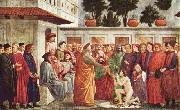Wholesale Oil Painting No Minimum |
|||||||||||
|
|
|||||||||||

|
|||||||||||
|
|
|
||||||||
MASACCIOItalian Early Renaissance Painter, 1401-1428 was the first great painter of the Quattrocento period of the Italian Renaissance. His frescoes are the earliest monuments of Humanism, and introduce a plasticity previously unseen in figure painting. The name Masaccio is a humorous version of Tommaso, meaning "big", "fat", "clumsy" or "messy" Tom. The name was created to distinguish him from his principal collaborator, also called Tommaso, who came to be known as Masolino ("little/delicate Tom"). Despite his brief career, he had a profound influence on other artists. He was one of the first to use scientific perspective in his painting, employing techniques such as vanishing point in art for the first time. He also moved away from the Gothic style and elaborate ornamentation of artists like Gentile da Fabriano to a more natural mode that employed perspective for greater realism. Masaccio was born to Giovanni di Mone Cassa??i and Jacopa di Martinozzo in Castel San Giovanni di Altura, now San Giovanni Valdarno (now part of the province of Arezzo, Tuscany). His father was a notary and his mother the daughter of an innkeeper of Barberino di Mugello, a town a few miles south of Florence. His family name, Cassai, comes from the trade of his grandfather Simone and granduncle Lorenzo, who were carpenters - cabinet makers ("casse", hence "cassai"). His father died in 1406, when Tommaso was only five; in that year another brother was born, called Giovanni after the dead father. He also was to become a painter, with the nickname of "Scheggia" meaning "splinter". The mother was remarried to an elderly apothecary, Tedesco, who guaranteed Masaccio and his family a comfortable childhood. |
||||||||
|
|
||||||||
Resurrection of the Son of Theophilus
Resurrection of the Son of Theophilus Painting ID:: 59774 |
Resurrection of the Son of Theophilus Resurrection of the Son of Theophilus |
|||||||
|
CONTACT US |

